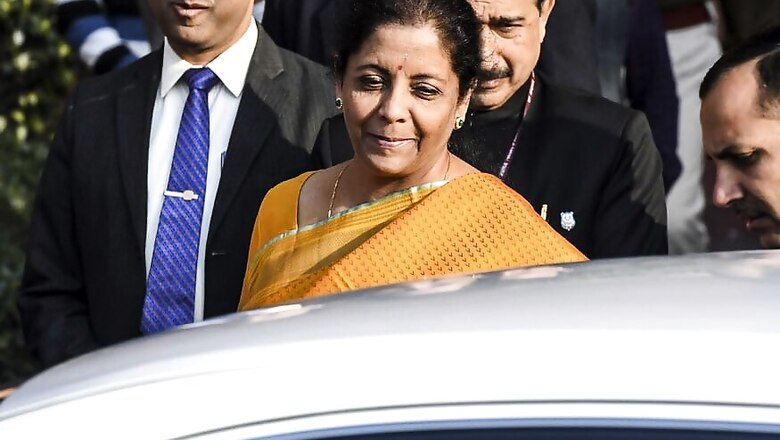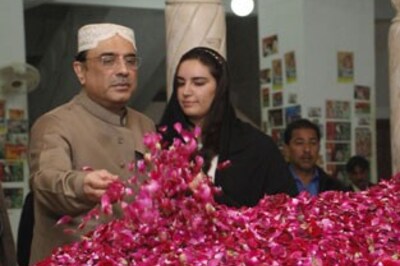
views
While presenting the Union Budget on Saturday for 2020-2021, Finance Minister Nirmala Sitharaman made an important point. She said that the people of India have unequivocally given their “jan-aadesh” in 2019 “for not just political stability” but also “reposed faith in our economic policies”.
The fact that people re-elected Prime Minister Narendra Modi with a massive mandate is an endorsement of India’s economic policies, largely shaped by his vision. It is a testimony of the fact that the economic trajectory of the country since 2014 has taken the right course, which brought development and prosperity to all sections.
While reading out her impressive speech, Sitharaman said “this Budget is woven around three prominent themes which are ‘Aspirational India’, ‘Economic development for all’ and a ‘Caring Society’”. These themes aptly sum up the philosophical core of the BJP evolved over the years and expressed in terms of Modi’s exhortation of “Sabka Saath, Sabka Vikas, Sabka Vishwas” and the concept of Antyodaya that has been a sacred talisman and article of faith for each and every BJP member.
While the concept of Antyodaya, translating into the “rise of the last person”, has been conceptualised by Deen Dayal Upadhyay and followed by generations of BJP leaders and karyakartas, the narrative of ‘Aspirational India’ bears Modi’s imprint.
In her speech, Sitharaman defined ‘Aspirational India’ as “in which all sections of the society seek better standards of living, with access to health, education and better jobs”.
I believe the power that will catapult India in achieving this will be the youth of the nation. And, for this reason, the youth has been the focal point of numerous development projects initiated under Modi’s leadership and their development has been central to the development narrative in the last six years.
In the current Budget too, development of the youth has been ensured by giving substantial importance to education and training of youth and creating new avenues for utilising the potential of the young workforce.
As highlighted in the Budget, India by 2030 is set to have the largest working-age population in the world and the fact remains that they not only need literacy but also jobs and life skills. For this a robust education system is required, which can train and equip this young workforce to meet the ensuing challenges.
Keeping this in mind, it has been decided that the New Education Policy will be announced soon.
The Budget clearly states: “It is felt that our education system needs a greater inflow of finance to attract talented teachers, innovate and build better labs. Therefore steps would be taken to enable sourcing External Commercial Borrowings and FDI so as to able to deliver higher quality education.”
One of the criticisms of the Indian education system has been that it doesn't contribute significantly to employability and the students of the “general stream” have been the worst hit by this. Accepting that students in this stream (vis-à-vis services or technology stream) need their employability improved, it has been decided that about 150 higher educational institutions will start apprenticeship embedded degree/diploma courses by March 2021.
The government also proposes to start a programme in which urban local bodies across the country will provide internship opportunities to fresh engineers for a period of up to one year.
Most importantly, to ensure equal access to education and provide quality education to students of deprived sections as well as those who do not have access to higher education, there is a proposal to start a degree-level full-fledged online education programme. This will be offered only by institutions ranked within the top 100 in the National Institutional Ranking framework.
A National Police University and a National Forensic Science University are being proposed in the domain of policing science, forensic science, cyber-forensics that will create news avenues of employment for the youth.
No one can contest the fact that Indian youth is the propeller of amazing innovations and are behind the success stories of many national and international ventures.
Sitharaman in her speech said that entrepreneurship has always been the country’s strength. The government recognises and appreciates this spirit of entrepreneurship and aims to go further to support and promote a whole new generation of entrepreneurs and wishes “to create more opportunities and remove road-blocks from his path”.
To do so, it has proposed to set up an 'Investment Clearance Cell' that will provide “end to end” facilitation and support, including pre-investment advisory, information related to land banks, and facilitate clearances at Centre and state level through a portal.
Since assuming office in May 2014, Modi has shown immense faith in the youth of the country. The government has invested prominently in schemes and programmes that aim at empowering youth.
From launching initiatives like Atal Incubation Centres, Skill India Mission or launching 'Beti bachao, beti padhao' campaign, it all aimed at strengthening the youth, irrespective of their gender, caste, class, religion and the instrument of their empowerment has been education, skillsets, opportunities and a vision that works for the nation-building. This Budget also aims in a similar direction.
(The author is a BJP MLA from Gautam Budh Nagar. Views are personal.)




















Comments
0 comment